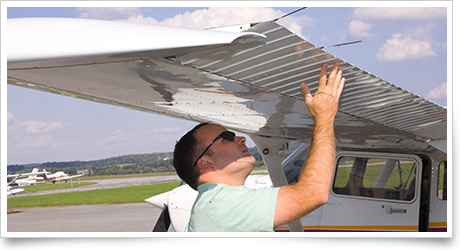training tipsAn electric atmosphere
As the applicant inspects the trailing edge of the Cessna 172’s wing, the examiner points to a wire-like object protruding from it and inquires about its purpose.
“That is a static wick,” the applicant responds. “It dissipates static electricity that builds up in flight.”
Correct. Friction generated as an aircraft moves through the air can cause a buildup of static electricity. Static wicks transfer the static electricity back to the atmosphere. Otherwise, navigation and communication radios might not function properly.
The examiner inquires if wicks are the only means by which an aircraft dissipates static electricity.
Typically, but not always, as explained in this October 2010 Flight Training article: “The FAA’s aircraft certification regulations don’t require static wicks per se, but they do require a way to dissipate energy. In most cases, that means we have the wicks, which can be easily seen on the trailing edge of the wings and the empennage. In fact, you’ve probably been scraped by one already.”
After you rub your head from colliding with a static wick, check the condition of the wick. Broken or missing wicks could reduce the aircraft’s ability to dissipate electrical charges.
Even if the aircraft you fly has never seemed to encounter any difficulties associated with static electricity, be wary of atmospheric conditions that could elevate the risk.
Precipitation static, or P-static, is a serious concern for instrument pilots, but VFR pilots sometimes also must fly in precipitation using radio navigation. Signs of P-static include high-pitched squealing or “motorboat” noises from radios, or erratic magnetic-compass indications. “This electrical discharge builds with time as the aircraft flies in precipitation. It is usually encountered in rain, but snow can cause the same effect. As the static buildup increases, the effectiveness of both communication and navigation systems decreases to the point of potential unusability,” explains Chapter 11 of the Instrument Flying Handbook .
“To reduce the problems associated with P-static, the pilot should ensure the aircraft’s static wicks are properly maintained and accounted for.”
Static electricity is not exclusively an in-flight concern. The next time your aircraft is refueled, observe how the line staff will run a ground line from the fuel truck or pumps to a metal aircraft component to prevent a static-electrical spark from igniting fuel vapor. training productsSporty’s has cut the price on its online instrument rating course from $265 to $199.99. The university-level Complete Instrument Rating Course offers detailed video segments covering both glass cockpits and analog gauges. The course offers complete preparation for the FAA tests and for real-world flying after a checkride.
MyPilotStore.com is offering the Deluxe Helicopter Pilot Training Kit with DVD. The kit includes a 90-minute Helicopter Fundamentals DVD video that guides viewers through the important concepts and vagaries of helicopter flight. Aerodynamics are covered in detail from retreating blade stall to autorotation. Cockpit point-of-view footage helps viewers experience maneuvers from the pilot’s perspective.
Note: Products listed have not been evaluated by ePilot editors unless otherwise noted. AOPA assumes no responsibility for products or services listed or for claims or actions by manufacturers or vendors. final examQuestion: How long should you wait to go flying at night after looking at a bright light?
Answer: You should wait 30 minutes. Exposure to light could cause temporary blindness, and drastically decrease your night vision. We must keep this in mind when taxiing around other aircraft, as our strobe lights may ruin another pilot’s night vision. Using strobes while taxiing would be comparable to driving at night with your high beams on all the time. One should not stare at runway end identifier lights, seen as flashing strobes at the end of some runways, while taxiing because doing so could cause temporary blindness. Read more about night vision here.
Got a question for our technical services staff? Email [email protected] or call the Pilot Information Center, 800/872-2672. Don’t forget the online archive of “Final Exam” questions and answers, searchable by keyword or topic. |
 A designated examiner is observing as a private pilot applicant performs a preflight inspection.
A designated examiner is observing as a private pilot applicant performs a preflight inspection.

